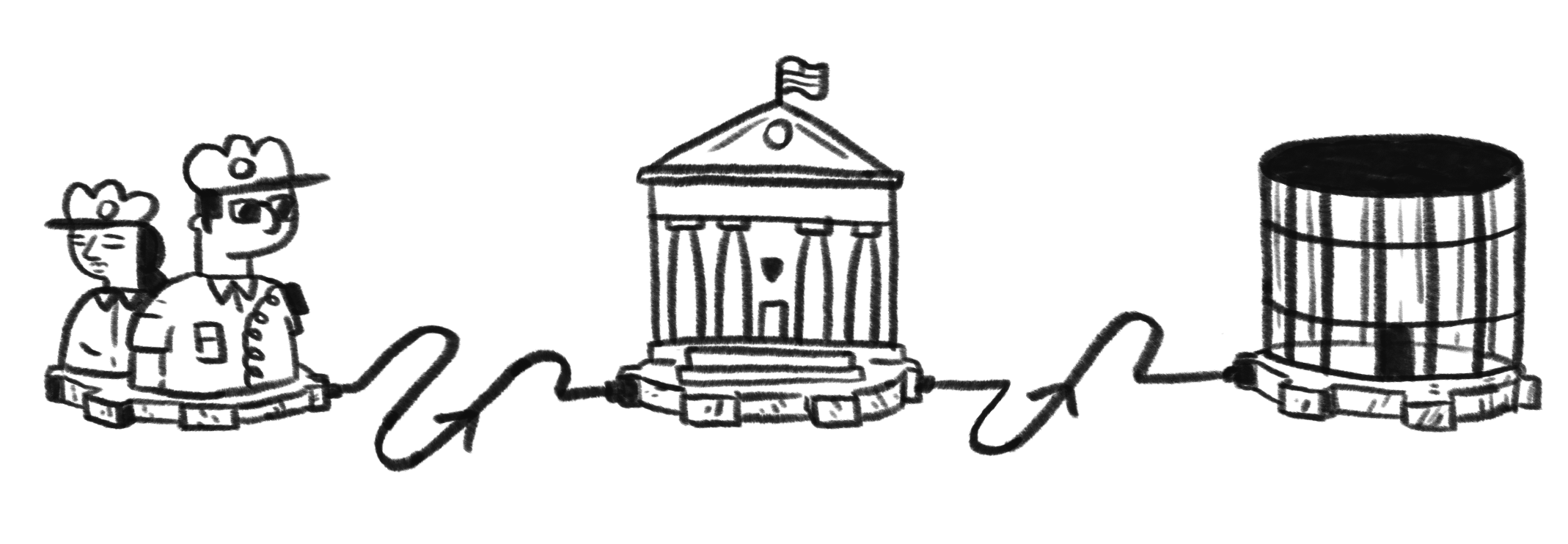The U.S. Supreme Court’s overturning of Roe v. Wade in June is only the latest decision, of several other recent rulings and individual justices’ actions, that have led to ever-increasing public questioning of the legitimacy of this country’s highest court. Polling from late June shows public approval for the Supreme Court at 25 percent, a historic low. Blame for the loss of trust in the court is placed on its conservative majority, several of whom were dubiously appointed, and inconsistencies in their rulings, clearly motivated by a far-right authoritarian, political agenda.
While the public’s diminishing faith is understandable, it also slightly misses the mark. Instead, we argue, the distrust should go further and should extend to courts at all levels of government today, especially criminal courts. Criminal courts play a significant role in American society precisely because of deep-seated inequality and deficits in democracy. And they, in turn, perpetuate those very social hierarchies.
Last week, we at Community Justice Exchange, with our partners at Interrupting Criminalization, launched a series of digital resources that make the case for the inherent illegitimacy of criminal courts, contending that they cannot be reformed — but like police, prisons, and the entire prison industrial complex — must be abolished. We’re certainly not the first to make this argument, but we wanted to create something specific for organizers who are looking for tools to build the power we need to defund, divest, and ultimately dismantle criminal courts for good.
Why focus on criminal courts?
Over the last decade, there has been a growing consensus to “reform” or redress mass incarceration. During the uprisings in the summer of 2020, we saw people flood the streets with the demand to defund and abolish the police. Building on long-standing organizing and theorizing that has made the case for abolishing police and prisons, we wanted to focus on the carceral space that exists in between the two: criminal courts. Criminal courts, along with policing and imprisonment, are an integral piece of the prison industrial complex. They are spaces where prosecutors, judges, court officers, and police officers work hard, every day, to criminalize and control other people — most acutely Black, Indigenous, disabled, migrant, poor, trans, and queer people. We wondered what it would mean to examine criminal court through an abolitionist lens: How might this analysis support and augment organizing to dismantle the entire PIC?
Read the resource
When we use the term criminal court, we are describing the legal institutions, processes, procedures, and actors that are involved in the progression of criminal cases. In criminal cases, the government, not the person who says they were harmed, prosecutes individuals or institutions based on a possible violation of criminal law. Even before a case is resolved, the process of prosecution itself creates additional harms — separating families, confining people to cages, placing them under surveillance, depressing wages, and inflicting long-lasting emotional distress. If the prosecution succeeds, the person accused is convicted and punished further. In the United States, criminal law, criminal procedure, and criminal courts are intertwined with the dispossession of Indigenous communities and the funneling of Black people into unfree labor. To this day, criminal law remains a critical tool for managing the crisis that is racial capitalism. In “Criminal Courts 101”, we go through the steps of a criminal court case, noting the layers of oppression built into the laws, rules, processes, and procedures that we’re often told are objective, neutral, and fair.
Beyond reforms
So what is to be done? For several years, we’ve been involved in or closely observing efforts to change the dynamics inside criminal courts. Across the country, we’ve seen organizers, lawyers, and legislators try to change the rules of the game, which system actors call criminal procedure. At almost every stage of a criminal case, those rules give prosecutors an advantage. So it’s not surprising that reformers have been attracted to rewriting those rules in order to level the playing field between the defense and prosecution. But just because the system is unfair doesn’t necessarily mean that making it fairer is either a realistic or desirable solution.
Until recently in New York, a prosecutor was not required to turn over important pieces of evidence until the eve of trial. Given that over 90% of cases end in a plea bargain, most New Yorkers being prosecuted would take guilty pleas without having access to all the evidence against them. Imagine making one of the most consequential decisions in your life, but being denied access to the very information that would help guide you in that decision. Called the blindfold law, its injustice is not hard to see. Public defenders, organizers, and advocates mobilized for years to modernize the state’s antiquated discovery practices. They finally succeeded in 2019, securing discovery reform.
On the one hand, this story is a progressive success: People accused of crimes are not entering proceedings blindfolded to the evidence against them. But the metrics of success matter. The law’s goal, according to its most ardent supporters (and authors), is to ensure that the system is “more fair and reliable, yet fully workable.” It aspires to “more orderly trials” and aims to minimize wrongful convictions. A law like this does not necessarily mean less people are likely to be arrested, prosecuted, or incarcerated. And it doesn’t necessarily lead to better outcomes. Many accused people have done the thing they are accused of, so quicker access to evidence does not always prevent their incarceration.
Procedural reforms are both important and a red herring. Because while they may reduce harm in the short term, we have seen that they are easily circumvented by prosecuting offices and judges. They can also necessitate new funding streams to system stakeholders in order to ensure they can be exercised. More processes often mean more technology, more staff, and therefore more capacity for criminalization. And they further entrench in our consciousness that it is possible to wring justice out of today’s system. Indeed, after the New York legislature passed discovery reform, prosecutor offices asked for more money, explaining that the law’s early and mandatory disclosure requirements had created more work for its line assistant district attorneys. Legislators met their request. After pressure from the prosecutor’s lobby, legislators also created a carve-out that would protect prosecutors if they did not comply with their new obligations.
Discovery reform in New York is but the latest in a long string of efforts to reform criminal court. As Naomi Murakawa chronicles in her book The First Civil Right, progressive court reform has a long vintage. In response to social protests during the 1960s, the federal government became increasingly eager to cultivate reverence for law enforcement and obedience to criminal law. Their solution: Create a commission that would propose reforms to carceral agencies, like courts, prosecutors’ offices, and police departments in the hopes of shoring up their legitimacy. The commission’s 1967 report, The Challenge of Crime in Free Society, proposed measures to modernize and standardize the administration of criminal law. Many progressives embraced the report and its recommendations, like access to counsel and uniformity in sentencing, hoping these would eradicate the excesses of the system. Yet Murakawa shows how the court reforms promoted by the commission were easily incorporated at the same time as carceral institutions steadily gained strength, setting the stage for the era of mass criminalization.
This history offers a cautionary tale for our present moment. While there are many deeply unfair practices embedded in criminal court, and it is tempting to try to tinker with the rules that produce those outcomes, doing so might do little to shrink prosecution and criminalization. Instead, they might further legitimize the system.
More broadly, these procedural efforts might actually foster the impression that the problems of criminal court have been remedied. These efforts can confuse the symptom with disease. As we show in “Common Questions About Criminal Court Reform,” many of the reforms aimed at criminal courts preserve or expand criminalization, whether intentionally or inadvertently. And unsurprisingly, the country continues to arrest, supervise, and incarcerate millions of people. We survey some of the familiar reforms directed at criminal court — from diversion programs to electing reform-minded prosecutors — and tease out whether and what kinds of measures might actually reduce the harm of the prison industrial complex. We argue that rather than trying to make criminal courts more fair, more transparent, and more attentive to trauma, it’s high time to move beyond them. By doing so, our hope is to avoid the pitfalls of cooptation and to advance strategies that address the root of the problem: criminalization itself.
Steps towards abolition
Luckily, we can look to examples of folks already organizing to build power in order to shrink the power, size, scope, and resources of criminal courts — interventions that many abolitionists refer to as “non-reformist reforms,” “transformative changes” or “abolitionist steps.” These kinds of changes are distinct from what are referred to as “reformist reforms” or “reformism” because abolitionist steps serve to chip away at the current system — that is, reduce the system’s size, scope, power, and/or legitimacy — while also strengthening the power of abolitionist movements, as opposed to tweaking aspects of the system while continuing to preserve and entrench its power. Non-reformist reforms are changes that organizers can fight for now to get us closer to an abolitionist future.
One kind of organizing, represented by bail funds, participatory defense, and other bottom-up interventions, tries to disrupt and intervene in court processes in real time. As law professor Jocelyn Simonson has written, communities affected by criminalization “have fashioned their own ad hoc forms of communal intervention on behalf of the powerless,” and in the process they “reinvented the place of community in local justice.” While the current criminal legal system exists, these kinds of organizing interventions are necessary, stop-gap measures that provide opportunities to shift resources, build power, and prevent or free people from incarceration or other forms of carceral control.
Another mode of organizing tries to cut court and prosecutors’ budgets. This work to defund courts often builds on ongoing campaigns to defund the police. For example, in 2021, the Seattle Solidarity Budget coalition called for a 50% cut to funding for the criminal divisions of the City Attorney’s Office and the Seattle Municipal Court. The City Attorney’s Office prosecutes misdemeanors in municipal court where poor people are targeted, hidden, and dehumanized. The coalition also called for decriminalization of misdemeanor offenses. In their budget proposal, the campaign rejected the municipal court’s justification for increased funding and power based on offering alternatives to incarceration for misdemeanor offenses: “Court[s] and prosecutors are not social service agencies, and should not be the gateway to housing and treatment. Just as responses to mental health crises belong in community hands . . . courts and prosecutors should not be funded to provide the basic support and programming people need.”
At the heart of organizing that aims to defund carceral institutions are community efforts to reimagine public safety and public spending. Organizers in Seattle and other cities have developed their own proposals for budgets that would create greater safety for all. Budgets are reflections of community values and priorities. What governments decide to fund and what they decide not to fund are deeply political decisions that are ripe for contestation. For organizers, conversations around budgets are an opportunity to invite community members to reimagine our public institutions and to create the kind of world people need and deserve.
Beyond criminal courts
Abolition is always simultaneously about dismantling and building. In this project, we make the case for why criminal courts cannot be reformed — why we must pursue organizing strategies that shrink their size, scope, and power. For the abolition of the current system to be possible, however, we know we need to build the world — and invest in the institutions — that actually keep people safe, like accessible and affordable housing, healthcare, healthy food, and clean water. And yet even in a future world where people’s needs are met, harm will still occur. This means that as we build a society that creates the conditions for us all to flourish, we must also imagine ways to evaluate and adjudicate harm, violence, and abuse outside of systems of surveillance, policing, punishment, and exile. This is a challenging task, and one we take up as a necessary component to this project, without offering the answers.
This is because the answers are not simple one-to-one substitutions — we need entirely new ways of relating to one another. Criminal courts currently structure our relationship to harm and accountability. Within an adversarial system, it is only natural to resist accountability for fear of punishment. There are often no material incentives for taking accountability and repairing harm. This does not mean we should not experiment and imagine different ways of dealing with harm now; it just means that we can still say no to a current death-making system without having the perfect solution at our fingertips. In fact, the very act of moving away from systems of punishment and control will likely open up more space to explore and answer these questions about how to ensure real justice, accountability, repair, and safety for us all.
Image: Noah Jodice for Community Justice Exchange/Interrupt Criminalization


